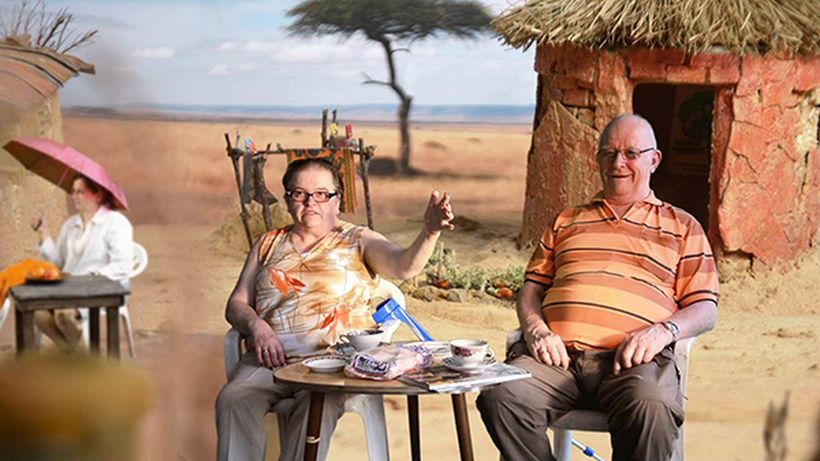An interview with Ulu Braun, who is represented at Berlinale Shorts already for the 6th time + an overview of the short film at the Berlinale
In Germany, the Berlinale is traditionally the first major industry and audience festival of the new year that also rolls out the red carpet for short film: from 16 to 25 February, 20 exciting short films from 11 countries will once again be screened at Berlinale Shorts, including 14 world premieres. A further 36 short films will be presented in the other sections (from a total of 239 films).
It is not an easy melange of global and discursive constellations in which the festival is taking place. The war in Gaza and the resulting #strikeGermany debate, as well as the scandal surrounding the invitation (and then disinvitation) of two AfD MPs, have confronted the Berlinale even more than usual with its reputation and responsibility as a political festival.
It’s only fitting that the Shorts are dedicating this year’s panel to arts and their dealing with the media: “Shorts, Communities and Conversations: Short Films in a Journalistic Context” (20 February, 11 a.m., Embassy of Canada; admission is free, but prior registration is required).
Formally and aesthetically, the Berlinale Shorts programme goes wild, with documentary-essayistic contributions, drawn and 3D animation films but also a number of live action film contributions, some of which appear rather naturalistic. There is also a wide range of topics. While many of last year’s films took a sober, detached look at the current situation, in many of this year’s films the end of humanity seems to be a long since decided fact: no less than three films depict the animal world either plotting revenge or sadly celebrating the apocalypse (WE WILL NOT BE THE LAST OF OUR KIND, LES ANIMAUX VONT MIEUX, KAWUSO). However, there are also queer love ghost stories in the programme (WANDERING BIRD), as well as allusions to stories of emigration that fade away in the shimmering heat (REMAINS OF THE HOT DAY), a private photo essay about the days before and after the Islamic Revolution (CITY OF POETS) or the wonderful and very touching “Baldilocks” by Marthe Peters, an autobiographical essay looking back on a childhood with cancer.
The high-calibre international jury consisting of Jennifer Reeder, Ilker Çatak, and Xabier Erkizia, which will select the Golden Bear from these entries, can be experienced at another event open to the public: “Short on Answers: Calling Film into Question”, an event organised by Berlinale Talents (22 February, 5–6.30 pm; tickets available via normal ticket sales).
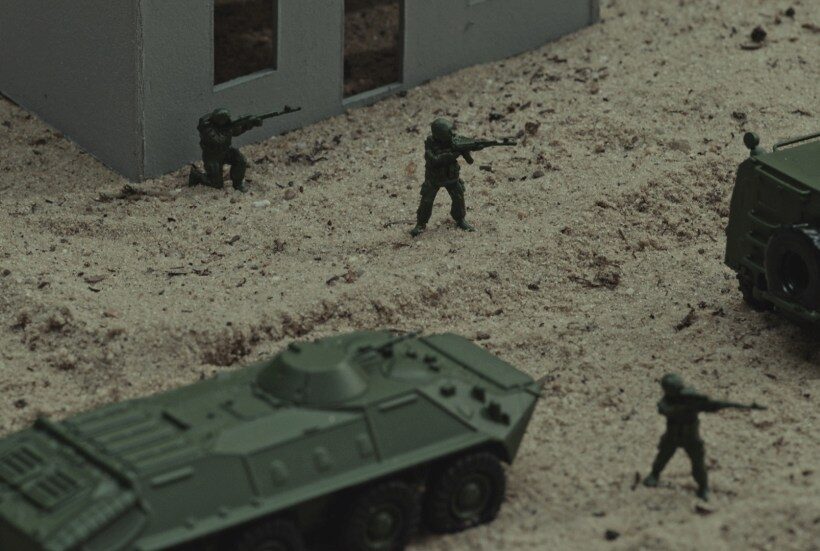
UNGEWOLLTE VERWANDSCHAFT © Jonas Römmig
Five productions from Germany or with German collaboration have made it into the selection. In UNGEWOLLTE VERWANDTSCHAFT (Unwanted Kinship), Pavel Mozhar once again applies his much-acclaimed tutorial aesthetic from HANDBUCH (Handbook) to explore the fact that his Belarusian compatriots are also involved in the war of aggression in Ukraine. Newcomer Boris Dewjatkin’s STADTMUSEUM is a fast-cut confessional video persiflage, in which the chaos and juxtaposition of building eras is evoked. In her documentary essay THAT’S ALL FROM ME, Eva Könnemann reflects on how motherhood can be combined with filmmaking in a mixture of video correspondence and ironic commentary. And the manually drawn TAKO TSUBO by Fanny Sorgo and Eva Pedroza explores why not having a heart doesn’t help either.
And then there’s PACIFIC VEIN by Ulu Braun, which for those familiar with his work ties in with a few common threads, such as criticism of capitalism. Quite a political programme going on here, isn’t it?
However, Ulu Braun, who lives between Berlin and Lieksa in Finland, would most likely not be so happy with the categorisation of his film as “political,” as he will explain later in the interview. For him, that would mean losing too much art. After all, Ulu Braun, born in 1976, feels equally at home in the worlds of art and film thanks to his collages, objects, video installations and films. A balancing act, because films or cinematically conceived works often have a difficult standing in the art context, but on the other hand it is also difficult to find acceptance in the film world with very artistic contributions, as he explains. And yet Braun, who studied painting and experimental film at the University of Applied Arts Vienna and film at the Film University Babelsberg Konrad Wolf, is successful in both areas: he has been screened six times at the Berlinale over the last 11 years – with FORST (2013), BIRDS (2014), ARCHITEKTURA (2015), BURKINA BRANDENBURG KOMPLEX (2018), DAS GLITZERN IM BARBIEBLUT (2021), and now with PACIFIC VEIN – whilst he is also represented at many other renowned international film festivals. Braun also won the German Short Film Award in 2013 with “Forst” and the German Competition in Oberhausen with HERBERGE in 2017. In addition, Ulu Braun’s works have already been shown at the Museo de Reina Sofia Madrid, the Museum der Moderne Salzburg, and the Institute of Contemporary Art San Diego, among others. For example, FORST and THE PARK are currently being shown as part of an exhibition at Hors Piste in the Centre Pompidou until 18 February. And on 7 February, SATURNE was screened at the Volksbühne, a feature-length film – because he is also dedicated to this format.
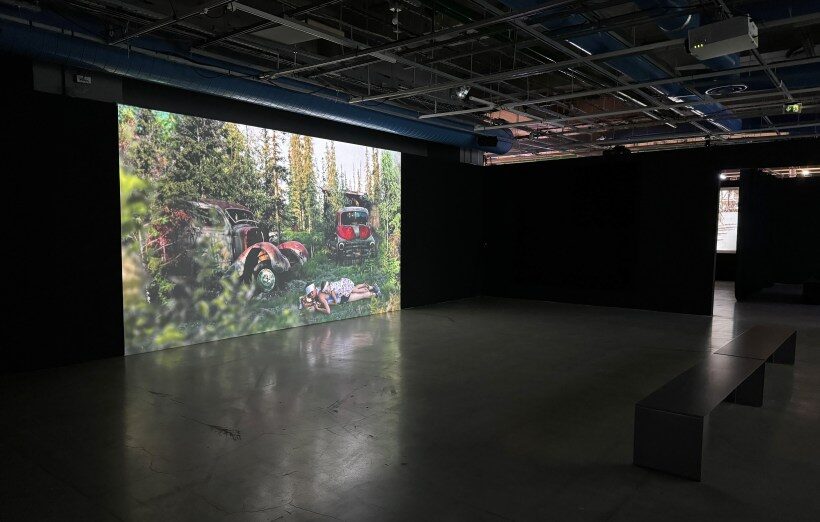
FORST (2013), exhibition view, Centre Pompidou, Paris, 2024, Fotocredit: Studio Ulu Braun & VG Bildkunst
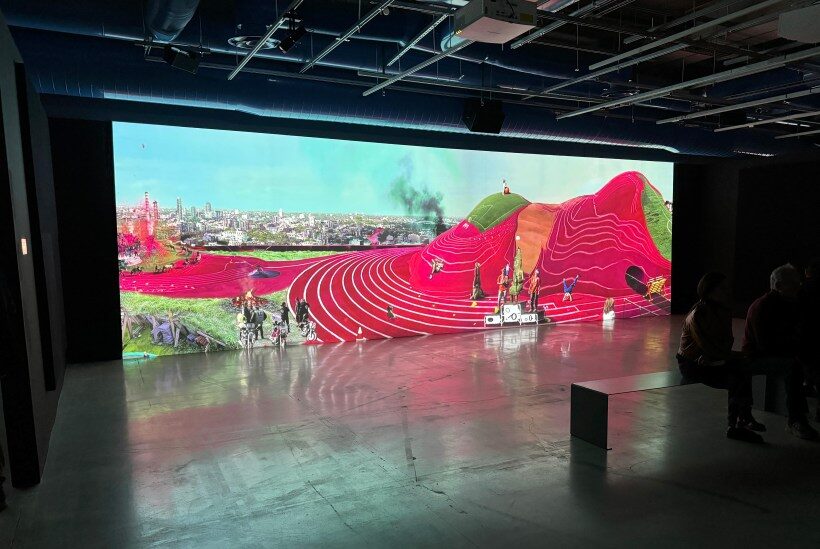
THE PARK (2011), exhibition view, Centre Pompidou, Paris, 2024; Fotocredit: Studio Ulu Braun & VG Bildkunst
Nevertheless, collage remains the essential form for Ulu Braun – his works are often literally teeming with references. With such a versatile interlocutor who thinks in all directions, it’s no wonder that we jumped back and forth thematically from time to time and would like to simply reproduce the interview in medias res:

Porträt ©Ulu Braun
shortfilm.de: One would think that the film and art worlds have a lot of overlap. Why do you perceive them as potentially antagonistic?
Ulu Braun:
The art world doesn’t really fit in with the cinema world. The cinema concept is associated with promise. I expect entertainment for the most part, and that’s why I buy a ticket. I want to “escape” from my familiar surroundings. Just like at the funfair in the old days when there were panoramic images. And when I understood this, I had to ask myself: do I want to serve the cinema format or not? Going against it – that makes no sense, because the “ticket people” don’t want to see that. Of course, you can also be provocative, but exhibitions are the more suitable context for this, because here you are confronted with provocation and the avant-garde. And if I don’t like it, I can walk away. Media and experimental film festivals are the only exception.
shortfilm.de: And despite these ambivalent feelings, you are now being featured at the Berlinale Shorts for the 6th time, and the Berlinale is even an audience festival!
Ulu Braun: Yes, that puzzles me too, but for me the differentiation is very important: I am an artist who makes films and not a filmmaker who makes art. Ideally, a work should do justice to both “sides” if possible: most of my projects can withstand both a screening and an exhibition situation. However, my intention is always to create a work of art when possible.
shortfilm.de: What are your criteria for this?
Ulu Braun: Very important: for me, a work of art is not didactic, it cannot be decoded completely rationally, it must be free. And: it does not serve a worldly function. This is why many political works often fail. When it comes to education, information, attitude exhibitionism, or infotainment, it is highly functional and therefore more a hybrid of applied art and journalism, pedagogy, or politics. I am not making a value judgement here, but I would like to plead for a clear distinction in terms of naming. Another example: a lot of what goes under the label “experimental film” has very little to do with the core of the term “experiment.” In my view, experimental film would be something that has never been seen before.
shortfilm.de: In PACIFIC VEIN the audience follows a camera ride through a kind of apocalyptic painting in which Musk and Bezos, among others, are romping around, while environmental pollution and drought are also topics. The film evokes associations with the exhibition project that you presented at last year’s FAB Dimensional at Silent Green, quasi moving paintings that sometimes remind me a little of Hierynomus Bosch.
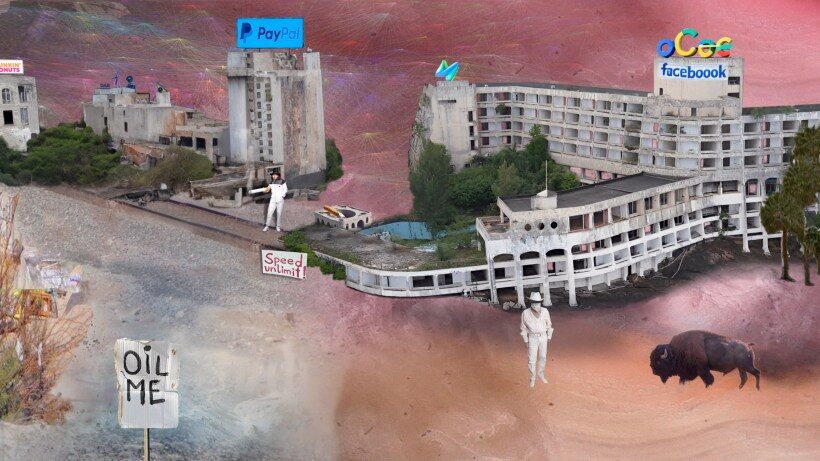
PACIFIC VEIN © Ulu Braun
Ulu Braun: For PACIFIC VEIN I adapted the collage principle that forms the basis of my work for the moving image and translated it into a long camera movement. The painterly quality of the film is certainly rooted in its relationship to landscape paintings such as those created by Brueghel, among others. After all, they also always depict society. And I am interested in this form of social portrait, in which the themes and energies of different groups come together. Another aspect that always interests me is our massive use of media. I display these media quotes on an equal footing with documentary scenes and merge them into “reality in the 21st century.”
shortfilm.de: PACIFIC VEIN does indeed seem to be your most picturesque Berlinale contribution to date.
Ulu Braun: I use painting for backgrounds to counter realism. It also appeals to a sensual level. In this respect, abstraction is also freedom of thought. The surface is freely negotiated, also because the perspectives don’t have to be right. A head can simply float in the air.
shortfilm.de: PACIFIC VEIN is also the first project in which you worked with AI, isn’t it?
Ulu Braun: Yes, although I’m currently using artificial intelligence more intensively in another project. For me, it’s just a tool that complements my working portfolio. Initially, I was sceptical about the use of AI as it has and will have immense consequences for our field of work. It replaces many artisanal existences. People used to spend months creating illustrative image worlds. In the past, I too have worked on small-scale tasks for a very long time – and that’s why I now like to use artificial intelligence as a production accelerator (which itself then also becomes a media reference). Essentially, it’s like this: I either work with stylistics as a medial quote or use it so subtly that you don’t notice it. With PACIFIC VEIN, it is actually more like you don’t notice it.
shortfilm.de: Nevertheless, PACIFIC VEIN looks much more “perfect.” In other films, the collage often seems raw, like a disruption. Was the subtle perfection of the current film intended?
Ulu Braun: In FORST (Berlinale Shorts 2013), for example, I deliberately worked in a more raw way, revealing the collage. In PACIFIC VEIN, on the other hand, the “realism” emerged by itself – I didn’t set out to do that but followed my intuition.
shortfilm.de: What appears to be a common thread for me, despite all the differences, is that all your films work with a Western, capitalist system of symbols.
Ulu Braun: Fundamentally, these symbols trigger irritation in my everyday life. It can even lead to hatred. How do I deal with manipulative advertising or political indoctrination? Whether you like it or not, these symbols or products are charged with ambivalent values and messages. In Christian painting, there were historically charged subtle symbols that stood for something – for me it’s now Coca Cola and Mickey Mouse. They then become part of my portraits of society, I deal with them, I use them for something else, and ideally something poetic emerges. Which in the end is detached from any judgement of these capitalist symbols.
BURKINA BRANDENBURG KOMPLEX © Ulu Braun
shortfilm.de: For me, the most evident example of Western hybris is “Burkina Brandenburg Complex.”
For BURKINA BRANDENBURG KOMPLEX, which is a kind of hybrid live action film, I was interested in reversing these Western symbols. That’s also the basic idea of the film: in 100 years, Brandenburg might be a desert landscape that we imagine as a cliché of the savannah. And then a Black museum director tells us why plastic shovels and energy drinks are objects of great historical value. Basically, the question is: what makes up our culture and what will remain of it? Is it perhaps the plastic electric toothbrush?
shortfilm.de: This was followed by DAS GLITZERN IM BARBIEBLUT (Glittering Barbieblood), where, in contrast to BURKINA BRANDENBURG KOMPLEX and PACIFIC VEIN, you worked in a more classic documentary or essayistic style (as previously in BIRD). Associatively, we follow a child and his mother through a world interspersed with advertisements; it’s not clear whether the two of them are perhaps homeless. How did this come about?
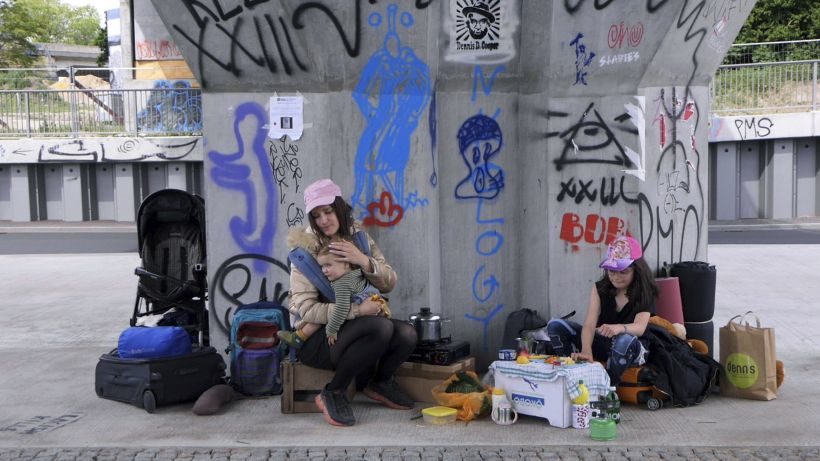
DAS GLITZERN IM BARBIEBLUT © Ulu Braun
Ulu Braun: When “filming”, you often have very little time and capacity to get involved in the reality of a location due to the planned scenes: You film the ice skater on the lake, but you miss the poodle tearing up a Disney cuddly toy next to it. When I follow this impulse and pan across, something emerges that is taken from “life” – a quality that I usually depict in my collages. DAS GLITZERN IM BARBIEBLUT is an attempt to capture this complexity. And on the ambivalence that was mentioned: are the mother and daughter actually homeless or, if so, how come they have so much money to be able to travel? That interests me, this simultaneity of symbols. For one thing, the tent is marketed as offering great freedom in the luxury sector, but the same image can also be used to symbolise homelessness. This is what also interested me with ARCHITEKTURA.
shortfilm.de: You said that you do a lot of filming yourself. Is your work process a solitary one?
Ulu Braun: In the beginning, my solitary work was certainly also down to fear and having little experience in communicating with others. You could say that I led the life of a slightly autistic painter. Working and communicating with others is now becoming increasingly constructive. For me, however, a well-planned film shoot is rarely an experience that I look forward to with anticipation, as others might do. I am more of a person who relaxes in the safe space studio once the shoot is finished. This is where I can create what I consider to be equally important works such as collages or objects. And this also changes my view of the various ongoing projects, which I can then steer in a “good direction” with a fresh perspective.
shortfilm.de: How do you finance your work, do you apply for film funding?
Ulu Braun: Fortunately, I’m fairly independent at the moment. Apart from art sales, I have benefited from the FFA reference funding for films that have already been able to collect points at festivals. It’s like a reward. With such reference funding – let’s say it’s €20,000 – I can then go ahead and make the next film. It’s a luxury that doesn’t exist in the arts. However, I find the orientation of German film funding questionable. Why are there no pots for independent feature-length films between €40,000 and €100,000 with lower bureaucratic thresholds? It’s not about business studies. A large film budget of two million euros could be divided into 20 projects of €100,000 each. I bet everything in the world that German films would be more successful this way on an international level. Even if there were only two outstanding, innovative, and daring films, a lot would have already been gained.
Beitragsbild: PACIFIC VEIN © Ulu Braun
